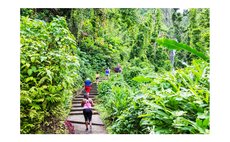Social media makes huge impact during Erika

Noted Dominican historian Lennox Honychurch spent Thursday 27 August on Facebook captioning photograph and reposting. It was the day Tropical Storm Erika poured 12 inches of rain on Dominica, leaving death and extensive damage in its wake.
"People are posting pictures without saying where they are or anything so I spent Thursday captioning pictures and resending, saying where things were and the background to it. In the case of Colihaut, they just had a picture of a house upside down, and I pointed out that in 1916 people died in Colihaut from similar floods," Honychurch told The Sun.
"Even CNN took a picture of the airplane that was floating down in Melville Hall and said it was Canefield . . . that [captioning] was very helpful for Dominican in the US and Europe who could not make out where thing were."
The first pictures of the damage caused by Erika were shown to the world via social media. Even while the country was still being pounded, photographs were appearing on Facebook and were being shared via mobile phones.
The government's communications consultant Charles Jong has been intimately involved in the social media and the information flow in the aftermath of the storm. He said the speed with which images reached regional and international media help galvanize coverage.
"For the first 48 hours… those with cell phones were able to get the message out. Without social media we would not be on the map right now in terms of access and getting the information out. It was very, very useful," Jong told The Sun.
Prime Minister Roosevelt Skerrit's Facebook page and Twitter handle were littered with dramatic images and video of the damage. Virtually every media around the world that covered the crisis used photographs or videos posted by the prime minister. This did not escape Honychurch.
"What was interesting was that the Barbadian press seem to be taking Facebook pictures and publishing. Much different from Hurricane David where they had to fly photographers in to take pictures and then fly back to Barbados, so it was days later [before the first images were published]," Honychurch observed.
"I think it's very important because it allows for people who are on the scene who still have some connectivity to get that message out. I saw very early, a picture of Petite Savanne. A lot of this would not be possible without social media. You can't sit down and wait for the (traditional) media to do that because they may be cut off themselves. The fact that cameras, albeit cell phone cameras are in the hands of everybody, gets the pictures out."
Social media has become an integral tool in crisis communications and is included in the plans of major corporations and institutions. The chief executives of these businesses (and destinations) recognize its use by the media and the general public.
According to Medium, a blog-publishing platform, 25 per cent of Twitter's verified users are journalists; Columbia Journalism Review states that 59 per cent of journalists are on Twitter; the Oriella PR Network found in a survey that 59 per cent of journalists worldwide use Twitter and that digital-first "is increasingly the norm", and the University of Indiana School of Journalism reports that 53.8 percent of journalists regularly use Twitter. In the UK 96 per cent of journalists are reported to use social media every day.
"Social media adds an element of speed and complexity to crisis communication," wrote blogger, marketer and member of the Public Relations Society of America, Jim Dougherty.
John Hallock, vice president of corporate communications for CareCloud, a provider of cloud-based practice management, electronic health record, and medical billing software and services, wrote in PR News: "Social media can act as a very fast and effective way to communicate with key stakeholders in the event of a crisis, as many individuals now use various social media conduits as their primary means for getting information."
This is what Skerrit and his team have been utilizing effectively during the present crisis.
"I do not know how we would have gotten word out so quickly, about the extensive damage, without social media and the recent implementation of our 4G mobile network. Persons from most parts of the island who, even though they lost electricity supply, were able to use whatever battery life remaining to share photographs and video recordings of the effects of Tropical Storm Erika in their respective areas. The quick transmission of this information was extremely helpful to the disaster coordination effort," the prime minister told The Sun.
"The high rate at which those photographs and video recordings was trending on Facebook, Twitter, and Instagram, also helped for quicker "take-up" by the International Press. Dominica desperately needs that International coverage now, now that we have identified a list of priority areas, a list of urgently needed medical supplies, and the ways by which persons, organisations, friendly Governments can assist financially. The website, www.opm.gov.dm, has all of the latest official information about the Government's announcements in relation to the recovery and reconstruction efforts and we have dedicated an area on that site for that effort."




